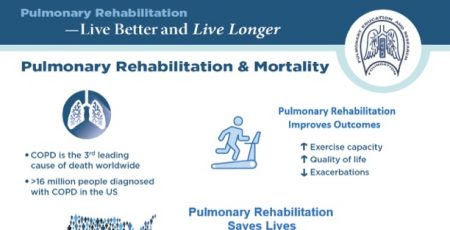28 Jul Exercise Testing Is Valuable In Measuring The Success of Treatments for COPD
PERF’s Richard Casaburi, Ph.D., M.D., Janos Porszasz, Ph.D., M.D., and Harry B. Rossiter, Ph.D., contributed to a study published earlier this year in the European Respiratory Journal regarding the use of exercise testing in evaluating the efficacy of various treatments for COPD.
The study found that exercise tests provide reliable measurements of the effect of both drug-based and rehabilitative treatments for COPD. Here are some of the findings:
In pulmonary arterial hypertension, peak oxygen uptake and the ratio of ventilation/carbon dioxide output are the variables most responsive to vasodilators (drugs that widen blood vessels).
High intensity endurance tests provide an effective way of measuring the effect of bronchodilators (drugs that widen the bronchi, or airways).
Responsiveness can be measured with tests of inspiratory capacity (the volume of air that can be taken into the lungs) and ratings of dyspnea (difficult or labored breathing).
Finally, the endurance shuttle walk test was found to be a reliable measure of a patient’s response to drug or rehabilitative therapies, but it’s been found that two repetitions are needed at the baseline point to establish an accurate initial measurement against which the test results after therapy will be measured.
As for the safety of exercise tests, all of the tests were found to be safe when recommended precautions are followed, though cardiopulmonary exercise tests often feature a higher level of monitoring which may constitute an additional safety measure.
Overall, it’s been demonstrated that performance during standardized exercise tests, taken together with associated measurements of physiological responses, are of considerable importance in the evaluation of most respiratory diseases. A correlation has been found between several measurements of physiological response and major clinical outcomes such as survival and hospital admissions, and this finding allows for significant improvement in providing an accurate forecast of the likely progression of a patient’s disease and of the appropriateness of therapies.
The United States Food and Drug Administration (FDA) and European Medicines Agency/Committee for Medicinal Products for Human Use have issued guidelines for the pharmaceutical industry regarding the usefulness of exercise testing as a measure of the efficacy of therapies in chronic obstructive pulmonary disease (COPD) and pulmonary arterial hypertension (PAH).
The researchers who participated in this study were:
Luis Puente-Maestu
Paolo Palange
Richard Casaburi
Pierantonio Laveneziana
François Maltais
J. AlbertoNeder
Denis E. O’Donnell
Paolo Onorati
Janos Porszasz
Roberto Rabinovich
Harry B. Rossiter
Sally Singh
Thierry Troosters
Susan Ward





No Comments